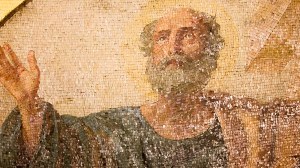In this series
1. What Did Paul Look Like?
He was a bald-headed, bowlegged short man with a big nose, and an unbroken eyebrow that lay across his forehead like a dead caterpillar.
That’s a paraphrase.
It’s from the only physical description of Paul, in an early Christian document, the Acts of Paul. (Its author, a second-century church leader, was fired over the book because he attributed to Paul some unorthodox teachings such as sexual abstinence in marriage.)
A more literal translation of the description of Paul in Greek reads, “A man of middling size, and his hair was scanty, and his legs were a little crooked, and his knees were far apart; he had large eyes, and his eyebrows met, and his nose was somewhat long.”
This may be little more than imaginative writing from a century after Paul died, but it does not clash with the way Paul’s critics described him: “His letters are weighty and forceful, but in person he is unimpressive” (2 Cor. 10:10).
2. Was Paul Married?
Probably not. But because Paul said almost nothing about this, there’s plenty of room to debate the matter.
When counseling singles and widows at Corinth, he wrote, “It is good for them to stay unmarried, as I am” (1 Cor. 7:8).
But when listing the rights of an apostle and arguing on behalf of himself and Barnabas, he said, “Don’t we have the right to take a believing wife along with us, as do the other apostles and the Lord’s brothers and Cephas?” (1 Cor. 9:5).
In interpreting this statement, some scholars say Paul’s question, taken with his statement that he was unmarried, suggests he was a widower who had at least occasionally traveled with his wife. Others see Paul using this question to emphasize that he and Barnabas, as single men, were not burdening the church with the added, though legitimate, expenses of caring for their wives.
3. What Was Paul’s “Thorn in the Flesh”?
We can only guess, but Paul gives two clues. He believed the purpose of the thorn was (1) “to keep me from becoming conceited” and (2) “to torment me” (2 Cor. 12:7). Whatever the thorn was, it humbled him persistently.
Scholars have diagnosed a full chart of physical diseases, psychological problems, and spiritual struggles—hysteria, migraines, epilepsy, and obnoxious Christians, to name a few.
A view from the Middle Ages said Paul couldn’t get sex off his mind. But that doesn’t fit with his words in 1 Corinthians: “I wish that all men were as I am.… But if they cannot control themselves, they should marry, for it is better to marry than to burn with passion” (7:7, 9).
Some scholars today suggest Paul’s thorn was his audience, the troublesome Corinthian church itself. In a word study of Paul’s statement, scholars point out that every time the New Testament uses angel/messenger, torment, and take it away, the words refer to people. Thorn doesn’t show up anywhere else in the New Testament, but a version of it appears in the Greek translation of Numbers 33:55 and describes what the Canaanites are to the Jews: “thorns in your sides.”
Most scholars today take literally Paul’s reference to the “flesh.” They see the thorn as a physical problem.
Some of them point out that Paul used the same Greek word when writing about the unspecified illness that kept him in Galatia. They speculate that in both cases Paul was talking about an eye disease—bad enough, perhaps, to make him today legally blind. For after mentioning the illness, Paul added, “If you could have done so, you would have torn out your eyes and given them to me” (Gal. 4:15). And at the end of the letter, Paul took the work from his scribe and added a personal postscript: “See what large letters I use as I write to you with my own hand” (Gal. 6:11).
Malaria is another possibility, suggested in the 1800s by archaeologist William Ramsay. What happened, Ramsay guessed, is that Paul caught malaria while traveling through the coastal plains of Pamphylia (western Turkey) during his first missionary journey. This coast’s marshes bred malaria-carrying mosquitoes. The tendency for malaria to recur with alternating bouts of sweating and shivering seems to fit well with Paul’s choice of the word torment, which refers to something that continually or often battered him.
Given the growing list of theories about Paul’s thorn in the flesh, the one thing we can be sure about is that we can’t be sure about any of them.
4. What Happened to Paul During the Unreported Gaps in His Life?
Twice Paul dropped out of New Testament history. He went to the Arabian desert for about three years, almost immediately after his conversion. Then following a two-week visit to Jerusalem, he was escorted out of town by some Christians who apparently feared for his life. They took him to the port city of Caesarea, put him on a ship, and “sent him off to Tarsus” (Acts 9:30), his boyhood home in western Turkey. There Paul stayed for the next half-dozen years or so, until Barnabas in the early 40s invited him to help lead the church in Antioch, Syria.
What Paul did during these missing years is uncertain. Raised to support himself as a tentmaker, he probably made a few tents. His years in the Arabian desert kingdom of the Nabateans, south of Damascus in what is today Jordan, were perhaps given to private reflection and ministry to Gentiles. And in Tarsus he probably remained true to his tendency to speak his mind. Perhaps his success there is why Barnabas called on him.
Paul’s account of these mysterious years is succinct but suggests he told others what he knew about Jesus, for the report circulated that “The man who formerly persecuted us is now preaching the faith he once tried to destroy” (Gal. 1:23).
5. How and When Did Paul Die?
The New Testament doesn’t tell us. Acts ends with the cliffhanger: Paul under house arrest in Rome while awaiting trial. What happened next, the writer didn’t say. Perhaps he figured his readers knew.
Christians, in fact, did know. Early Christian writers agree that Paul was martyred in Rome. The first person we know of who said this was a Roman bishop, Clement, writing to the Corinthians in 96, roughly 30 years after Paul’s execution. Gaius, a second-century church leader in Rome, said he could point out the grave monuments of Paul and Peter on Vatican Hill (later leveled to build St. Peter’s Basilica).
Paul was probably beheaded with a sword. That was the quick method of execution granted to Roman citizens found guilty of a capital offense. Non-citizens often faced the lingering death of crucifixion.
The most vexing question about Paul’s death is when it took place. Many scholars argue it happened in about 62, at the end of Paul’s two-year house arrest in Rome. Luke’s abrupt ending in Acts could imply this.
Other scholars say the Romans released Paul, who briefly visited some churches he had planted and then turned west to evangelize Spain, a long-standing dream of his. Paul’s letter to Philemon, written when he was under house arrest, shows he expected acquittal: “Prepare a guest room for me because I hope to be restored to you in answer to your prayers” (Philem. 22). And in Clement’s letter to the Corinthians, he said that Paul “went to the limit of the West.” This points to Spain. If this is what happened, Paul was probably arrested a second time and executed at Rome in about 66.
More certain than the time of Paul’s death is the manner in which he faced it. In his last recorded words, he told Timothy, “I am already being poured out like a drink offering, and the time has come for my departure. I have fought the good fight, I have finished the race, I have kept the faith” (2 Tim. 4:6–7).
Stephen Miller is a free-lance writer and former editor of Illustrated Bible Life. He is a consulting editor for Christian History.
Copyright © by the author or Christianity Today/Christian History magazine. Click here for reprint information on Christian History.













